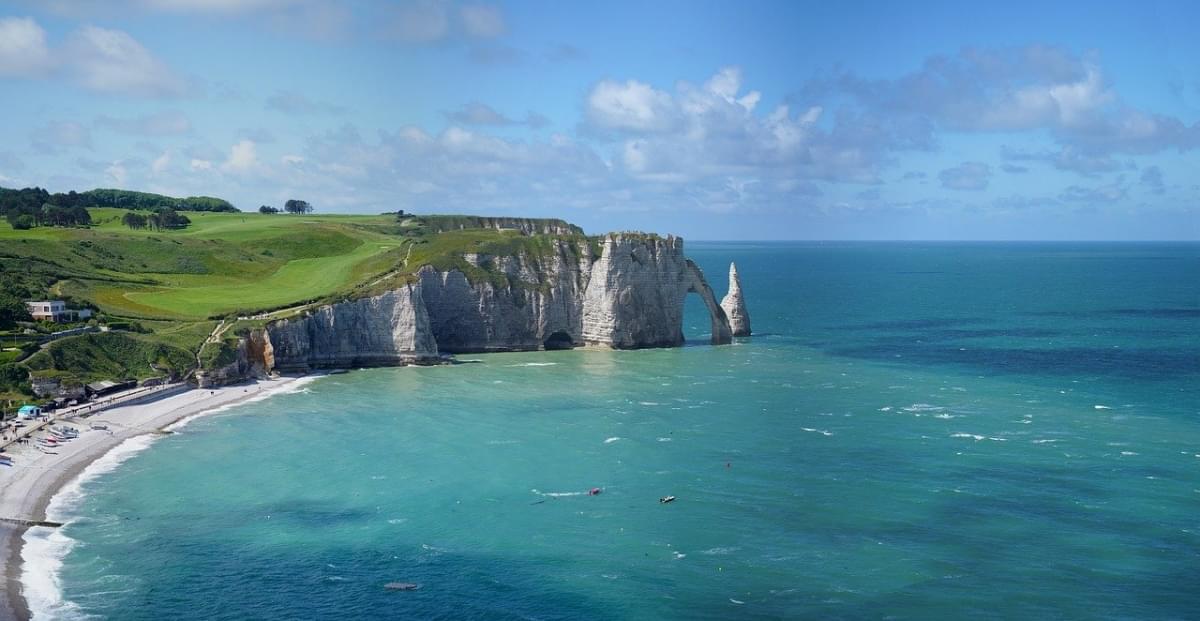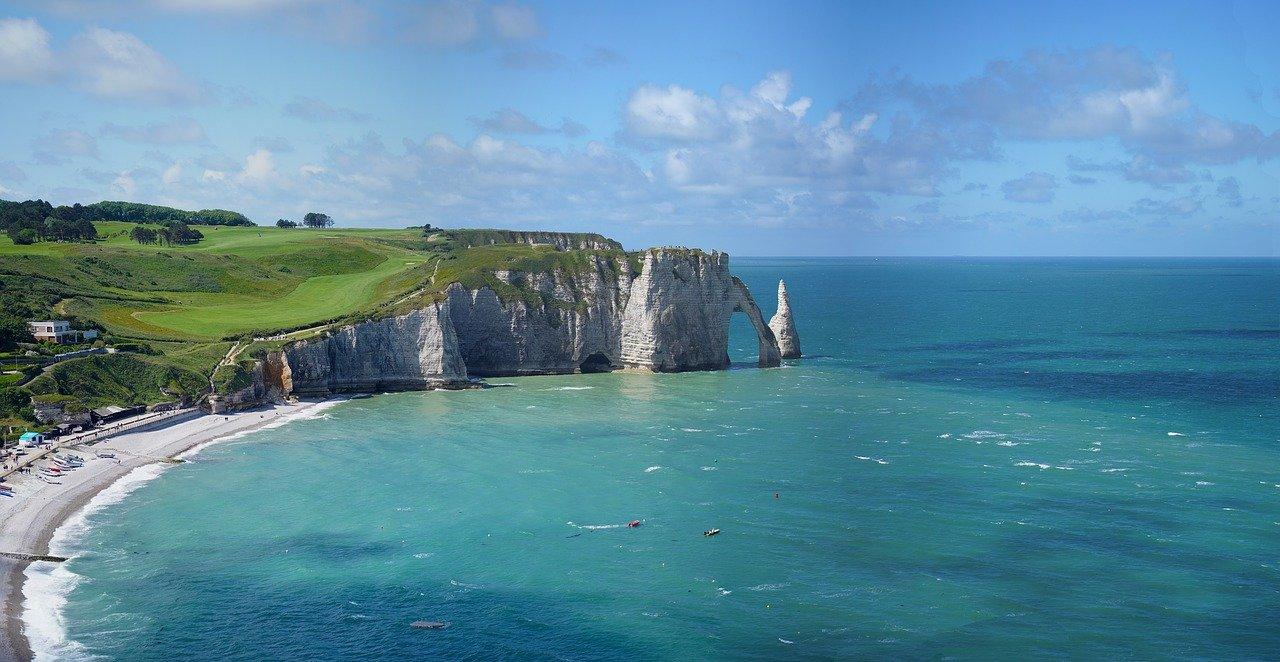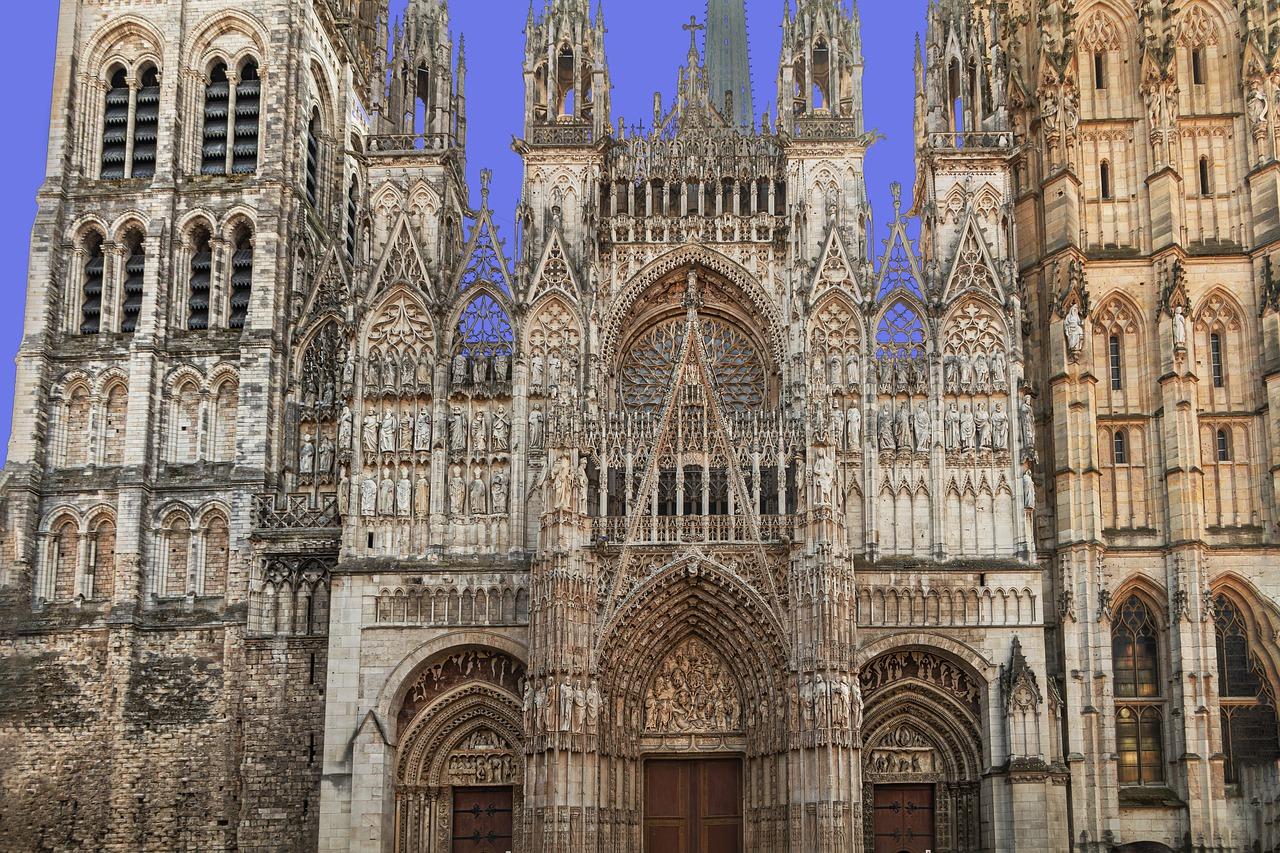
Normandy preserves relics of recent events, but also buildings and traces of the past, such as Rouen and its medieval appearance, Mont Saint-Michel, the municipality located on a small island that can become a hill depending on the tides, with its enchanting abbey. Art lovers can visit Monet's House and Gardens, and those who want to lose themselves in nature can hike the Etrat cliffs, naturally smoothed by the action of the Atlantic ocean and the wind.
Here's everything you need to know about Normandy, France: where it is, when to go and what to see!
Towns and attractions
1 - Mont Saint-Michel

Over the centuries, the abbey experienced a troubled history, and was also a state prison. After several changes in its function, during the second half of the 19th century Mont Saint Michel officially became a historical monument, later also a UNESCO World Heritage Site. It was only in 1969 that it became a place of worship again and was attended by a small group of religious people.
To get there, you can park your car in the car parks on the mainland, then use the free shuttle bus (there are frequent shuttles between 7.30 a.m. and midnight); alternatively, you can walk across the 3 km-long suspension bridge. Admission to the interior of the abbey costs €10.00 ( online ticket recommended), you can walk through its courtyards, cloisters and Romanesque crypts.
SEE ALSO: Guide to Mont Saint-Michel: where it is, when to go and what to see
2 - Étretat and its cliffs

This location on the alabaster coast is made up of natural limestone cliffs but also of white chalk cliffs; a large and peculiar 90-metre high chalk arch called Manneporte dominates the landscape. What makes this place unique in the world are the two sheer cliffs, Crag D'Aval and Crag d'Amont, where it is obligatory to go and admire the splendid view of the sea. On the first you can climb on foot, while to reach the other you can choose between taking a long walk or using your car.
The village of Étretat is really a very small town to walk around, its beach is made of pebbles. We also recommend a visit to the Jardins d'Etretat, a wonderful park from which to admire the surroundings!
3 - Honfleur

Honfleur has succeeded brilliantly in preserving the charm of its atmospheric and distinctive old town with its cobbled streets, typical boutiques, half-timbered facades, typical restaurants and the richness of its cultural and artistic heritage.
4 - Rouen

Rouen must absolutely be visited on foot! We recommend a guided walking tour with a local guide who will take you to discover the distinctive timber-framed houses and numerous churches, including the Gothic Saint MaclauI and the nearby Notre Dame Cathedral, rich in paintings by the Impressionist painter Monet and featuring a 150 m high spire. Then there is the Gros-Horologe, a peculiar one with allegorical figures representing the various phases of the moon.
Then take a walk along the Seine, which divides the city into the right-hand side, more ancient and very traditional, and the left-hand side, more modern and industrial. Rouen is also home to the Musée des Beaux-Arts and the Musée des Tournelles, both of which can be visited free of charge.
5 - Perche Regional Nature Park
The Parc naturel régional du Perche, in French Parc naturel régional du Perche, is 182,000 hectares large and is perfect for all lovers of outdoor activities, such as horse riding (thanks to the riding stations), cycling and hiking. It is also ideal for those who enjoy wine tasting and visiting beautiful abbeys, manor houses, farms and manicured gardens.
At the heart of the park is the Manoir de Courboyer, the information centre in the Courboyer manor in Nocé(Get directions), where you will find an exhibition on the history of the Perche. In addition, an 87-km-long tourist circuit also starts here, from which you can explore all the most beautiful manor houses.
The forests where you can venture are Réno-Valdieu and Belleme, perfect places to take long walks and listen to the sounds of nature in peace and recharge your batteries. The Perche eco-museum is also very interesting, especially appreciated by fans of popular arts and traditions.
6 - Château Gaillard

The building was erected on a cliff with a defensive function, to protect the village of Rouen and the entire duchy from repeated attacks by French troops. During the Hundred Years War, it was taken over by the British, and today only the square tower and the bases of a polygonal perimeter remain. In the past, there were two other majestic towers and the entire building was surrounded by a stone wall and a bridge connected the fortress to the village.
It is a unique testimony that will take you back in time, preferred not only by lovers of medieval style and art, but also by many annual visitors who want to discover the roots of Normandy.
7 - Giverny

You will be impressed by the picturesque water gardens, the many varieties of plants including the beautiful water lilies and the Japanese-style bridges. This beautiful earthly paradise is perfectly reflected in the works of the Impressionist painter, to whom the Giverny Museum of Impressionism is dedicated. Also not to be missed is a tour of Monet's house and gardens, a veritable work of art with its vibrant colours and lily pond. The ticket to visit both the museum and the house dedicated to Monet costs €9.50, but given the high number of tourists, we recommend purchasing the guided tour with entrance without a queue.
8 - Bayeux
The town of Bayeux boasts a rich medieval architectural heritage, with its beautifully preserved old town centre, ancient streets lined with typical half-timbered houses, and its Gothic-style Cathédrale de Bayeux (entrance fee €5.70), which is the centrepiece of the town and was inaugurated in 1077 by William the Conqueror. Also not to be missed is the famous Bayeux Tapestry Museum (admission €5.00), also known as Queen Mathilde's Tapestry, which narrates the exploits of William the Conqueror.
There are also several museums, including the Baron Gérard Museum, which brings together the most beautiful collections of local arts and crafts, the Lace Conservatory and the Memorial Museum of the Battle of Normandy, which expertly retraces the events that also recount how Bayeux became the first town to be liberated on 7 June 1944.
9 - The Landing Beaches
Some of the most important places in Normandy are the beaches that also marked the history of the entire world. This is a part of the coast from Deauville to Cherbourg, the French region most involved in and consumed by bloody battles during the Second World War.
These places offer their visitors extremely evocative views, but they are also places steeped in history, making them a favourite destination for military history enthusiasts.
We recommend the guided tour of the landing sites, to retrace all the milestones of the event: the village of Arromanches, where an artificial harbour was installed during the war to supply weapons; Omaha Beach with the Colleville cemetery that holds the remains of American soldiers who fell in the Battle of Normandy; the promontory of Pointe du Hoc overlooking the sea and the Caen Memorial (€14.50) where you can retrace the various stages of the Second World War conflict.
10 - Oak of Allouville-Bellefosse
The main attraction of the village of Allouville-Bellefosse is an oak tree considered to be the oldest and longest-lived in all of France. It is 18 metres high, about 1,200 years old and also has the peculiarity of having two chapels inside its trunk. It is an ancient Farnia and legend has it that it was planted there back in 931, in memory of the birth of the region of Normandy.
The village of Allouville-Bellefosse, of Gallic origin, is also known for its pretty centre full of shops and craftsmen's workshops. In fact, in 2010, it received the Jury's Special Grand Prize in the competition that rewarded towns and villages in bloom. The Nature Museum was founded in 1981 and collects the flora and fauna of the Caux region.
Main itineraries in Normandy

The best way to visit it is definitely to rent a car, so that you are free to reach all the towns and points marked on your route!
Here are some interesting itineraries to discover this fascinating region:
On the trail of Impressionism: start in Giverny, with Monet's House and Gardens, the Museum of Impressionism, then stop in Rouen, whose cathedral was the subject of the painter's famous series of paintings. Itinerary suitable for a weekend.
Gastronomic tour of Normandy: the region is famous for a number of culinary specialities, such as the fish recipes of Dieppe, Port-en-Bessin, Saint-Vaast-la-Hougue, the tasty cheeses of Pont-l'Évêque, Camembert, and the ancient distillery of Fécamp. Tour suitable for one week.
Tour to theD-Day Landings sites: you go to the places where the events of 6 June 1944 took place, such as the American cemetery at Omaha Beach, the Sainte-Mère-Eglise church, whose bell tower parachutist John Stelle was entangled in, and the Caen Memorial Museum. Itinerary suitable for a weekend.
On the coast from Étretat to Mont Saint-Micheal: on the white chalk cliffs of the small town of Étretat, there are several paths overlooking the sea, the most striking of which is the path leading to the D'Aval cliff, on top of which there is also a golf course. The tour ends with a rendezvous at the unmissable Mont-Saint-Michel, the islet emerging in the waters of the English Channel. Tour suitable for two days.
What to do in Normandy: excursions and tours
Travel information: useful info
Inhabitants: 3.2 million
Capital: Rouen
Languages: French and Norman
Local currency: euro (€)
Climate: Atlantic oceanic, average winter temperatures 5°, average summer temperatures 18°.
Distance from Italy: 1,495 km (2 h 10 min flight) from Rome
Where is it located and how to get there
Normandy is located in the north-west of France and comprises the territory of Haute-Normandie, which occupies the Seine valley, and that of the Cotentin peninsula, which is located in Lower Normandy. It faces the English Channel, between the mouths of the Bresle and Couesnon rivers.
The only airports in the region are served by seasonal flights, therefore not available all year round. Better to land in Paris. The airports are connected by regional trains (90 min/€24.00 to Rouen, 2h/€38.00 to Caen), or by coaches from Paris to Rouen (2 hours) or Caen (3 hours), average ticket cost is €13.50.
When to go? Info on climate and best time
Month | Average temperatures (min/max) | Precipitation (days/mm) |
|---|---|---|
January | 1 / 6° | 13 days / 75 mm |
February | 1 / 7° | 10 days / 60 mm |
March | 3 / 11° | 12 days / 65 mm |
April | 5 / 14° | 11 days / 60 mm |
May | 8 / 17° | 12 days / 75 mm |
June | 11 / 20° | 10 days / 65 mm |
July | 13 / 23° | 9 days / 70 mm |
August | 13 / 23° | 9 days / 65 mm |
September | 10 / 20° | 10 days / 65 mm |
October | 8 / 15° | 12 days / 85 mm |
November | 4 / 10° | 13 days / 75 mm |
December | 2 / 7° | 13 days / 90 mm |
Climate: Atlantic oceanic, winter averages 5°, summer averages 18°. Frequent rainfall, most intense from October to January, but also possible in summer, Atlantic disturbances make the climate in all areas rather variable
Best period: May to September, warmer and sunnier, although the temperature can drop considerably in the evenings
Period to avoid: December to February, it rains often and there are very few sunny days
How much does a holiday in Normandy cost? Prices, offers and advice

Accommodation costs vary according to the city, it is easier to find a wide offer in Rouen or Caen, while in the small villages there are few types of accommodation (in all cases the prices are not very cheap). In general, the cost of living is not very different from that in Italy.
Related articles
30 (great) ideas for your next hikes in France

Overseas: the islands of France
What are the 20 sunniest cities in France?
Discover the 20 hottest cities in France

What to eat in France: typical dishes, tips and curiosities about French cuisine

Urbex: discovering abandoned places across France and Europe
5 ghost towns to visit in France
Our selection of the best Christmas destinations in France